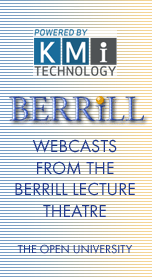
Event Summary
In this programme of school lectures, jointly organised with the Denbigh Teaching School Alliance, we bring together four Open University researchers. The four speakers work at the cutting edge of research in science, technology, engineering and mathematics, exploring the mathematics of pattern recognition, the parameters for life, how we learn through technology, and mountain building, respectively.
The talks will be followed by an opportunity to ask questions as the four speakers return to the stage for a panel Q&A session.
Presenters -
To repeat or not to repeat: The fascinating (and rather baffling) mathematics of quasicrystals
For humans, orderappears to be an intuitive and natural concept. Our brains are skilled and trained in detecting order in patterns, be in in nature or in the arts. You could argue that detecting order in nature forms the basis of scientific enquiry. It may thus be surprising that it appears to be difficult to pin down orderin terms of a precise (mathematical) definition.
The concept of “aperiodic order” is a fascinating area of mathematics that emerged over the past decades. It was partially motivated by the unexpected discovery a new type of material called quasicrystalsin 1982, later recognised by the award of the 2011 Nobel Prize in Chemistry to Dan Shechtman.
In this talk, I will show examples of intriguing patterns and tilings (such as the Penrose tiling shown here) and explain some of the mathematical concepts that are used to generate and to describe such structures.
Extremophiles: living life on the edge, and beyond
The enduring question of whether Earth is a unique location for life in the Solar System remains unanswered. The central element of theories about when, where, and under what conditions life may have existed elsewhere in the Solar System is dependent on the presence of liquid water.Promising targets include Mars, and the sub-surface oceans of the icy moons. Although there is liquid water the environmental conditions are extremely harsh and would not support human life.
On Earth, microorganisms have been found in some of the most extreme environments. These microorganisms are called extremophiles and can thrive in environments that were deemed inhospitable for life. For example, hydrothermal vents, acidic lakes and permafrost environments. If microorganisms can live within these environments can they survive and live elsewhere in the Solar System?
In this talk, I will discuss some of the possible habitable environments in our Solar System and the work I have been involved in looking at microbial survival in Space, on-board the International Space Station.
Learning with students at the centre: Developing educational technology through participatory design
Developing educational technology involves investigating the design and use of technology to enhance learning, but who knows best how you learn?
Learning is difficult to measure and what works for one person may not work for everyone. Design-based research in education involves working with educators and learners to understand their context and activities, and making incremental design changes that over time improve the learning experience.
In this talk we’ll look at how design-based research works in practice and we’ll consider the challenges and benefits it brings.
Unlocking the secrets of the Himalaya: mountains under the microscope
Devastating earthquakes and explosive volcanic eruptions routinely make headlines in our newspapers. They are a constant reminder that planet Earth is restless and evolving. However, there are much more subtle and secretive processes that are happening tens of kilometres beneath our feet that can, over time, lead to the formation of some of our planet’s greatest natural wonders.
The Earth’s magnificent mountain belts are unique in our Solar System. They are a product of plate tectonics, a phenomenon which drives the movement, formation and destruction of the Earth’s rocky crust. My research takes me to the Himalaya in Asia, where something as small as a single rock can help us wind-back the geological clock millions of years to show us how the mountain range formed.
In this talk, I will delve into the geologist’s toolkit to show how, under scrutiny in the lab, the smallest details in rocks can help us investigate the events that followed the Indian continent’s head-on collision with southern Asia. |
